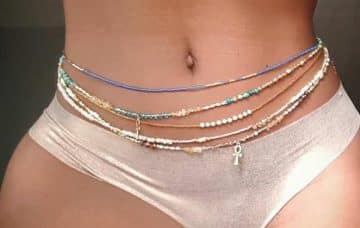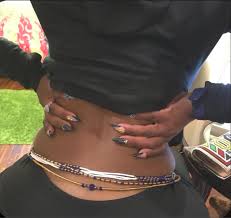Many men in the modern Africa are skeptical about approaching or having a romantic relationship with ladies that wear waist bead. This is largely due to the belief that wearing waist beads is for people who practice witchcraft. The question now is, “Is wearing waist bead witchcraft?” “I am a witch or a voodoo practitioner because I wear waist beads?”
Quick Facts About Waist Beads
Waist beads have been in use for as long as anyone can remember. Some girls do wear it on their waist when we were kids, and we saw no issues with it until we grew into our teenage years and begin to see things differently. Some parents claim their daughters wear waist beads from childhood in order to protect them from sexual harassment, cementing the belief that waist beads are associated with voodoo.
On the other hand, some grown ladies claim that waist beads help them shape their butts well, and it makes it easier for them to get men’s attention when they sway their hips coquettishly. This caused confusion; how can the same object, used to ward off immoral men from children, also be the same object that helps attract them to adult men? Whatever the truth was behind the waist bead, it caused a sense of alertness and caution in teenagers during our days.
In this article, we will consider the veracity of the statement that waist bead is witchcraft and by so doing, answer the question, “Is wearing waist bead witchcraft?” To do this, we will briefly highlight the history of waist beads, what they were originally used for, and how they became connected to witchcraft.
History of Waist Beads
Waist beads have been a common fashion accessory, among other things in Africa for some time. It was commonly called girdle in ancient Egypt, functioning in as much the same ways as what we know as girdles today. They were used to shape the waist, making it smaller while the hips widen.
The use of waist beads in Africa was popularized by the Yoruba culture from around the 15th century, and spreading to other surrounding parts of Africa, for fashion purposes. Beads are available in different African households in different shapes and sizes during those times, and the physical appearance differs, depending on the social status and wealth of the individual wearing them. For instance, a royalty wears beads on their heads, wrists, ankles, and waists, whenever they feel like it. Other maidens in the town, will wear theirs (excluding waist beads) only when there is a special occasion.
The people of Benin are known to love beads, they use them as fashion accessories and also as materials for art creations. In Ghana, many women wear waist beads to accentuate their voluptuous hips.
Purpose of Waist Beads
Waist beads are made with materials such as glass, wood, metal, bones, or stones. The more affluent the user is, the more special and costly the material used for the bead is. The stones, metals, or wooden beads are arranged on a string of cotton and tied off at one end. They usually have no hook with which they are held because they are meant to be worn until they fall off.
The major purpose of wearing waist bead varies among its users. Although many people who wear beads generally do so for fashion purposes. However, when it comes to waist beads, it does more than create a fashion statement. Its purpose ranges from symbolizing femininity – as a rite of passage into womanhood, display of affluence, spirituality, beauty enhancement, and so on.
As a display of affluence, many women historically wear waist beads to show their social status and wealth among their peers. As we have earlier explained, a royalty wears more beads than others as a sign of their position, even among their peers. Also, the number of waist beads and the materials the beads are made from are usually not the same as the ones the subjects have on.

Waist beads are particularly used to enhance beauty and increase the sexual appeal of many women in Africa. An average African lady is usually voluptuous around the hips; however, to make the hips appear bigger and the waist smaller, they will usually wear waist beads, to control the width to which the waist can grow – something like a girdle.
This practice is common among ladies that are of age and wanting to get attention of suitable men. It is a common practice that exists till date, even though there is less exposure of the mid-region of a woman’s body these days.
Also, the number of waist beads on a lady’s waist and the material calls attention to her as she walks and the beads clang against each other. It also excites the men and notifies them of the swaying hips.
The most controversial aspect of wearing waist bead, which makes it suspected of being affiliated to witchcraft is the spiritual purpose it sometimes serves. In the various African traditional religions, the use of bead for protection is common. In the Osun divination religion, a newborn usually has a wrist bead on them after birth to ward off evil perpetrators and attract goodness to the child. The rites that are usually done when these beads are being prepared is what makes them associated with witchcraft.
Our Take on If Wearing Waist Bead is Witchcraft
The African traditional religion does not connote witchcraft. Although some rituals and rites are performed, they do not necessarily mean they are attached to witchcraft. The use of beads for protection of people who practice the African religion does not make wearing waist beads evil.
Waist beads meant for spiritual protection are not usually sold as wares, they are made and specially prepared and fortified for their purpose. However, waist beads for fashion purposes, and improve sexual appeal, are easily bought in stores.
Do not deny yourself that sexual feature you’ve always wanted based on an erroneous ideology. Wearing waist bead is not witchcraft, it is a fashion accessory that can help you get bigger butts with smaller waists. To give you assurance that you’re not practicing witchcraft by wearing waist beads, you can make some by yourself.

